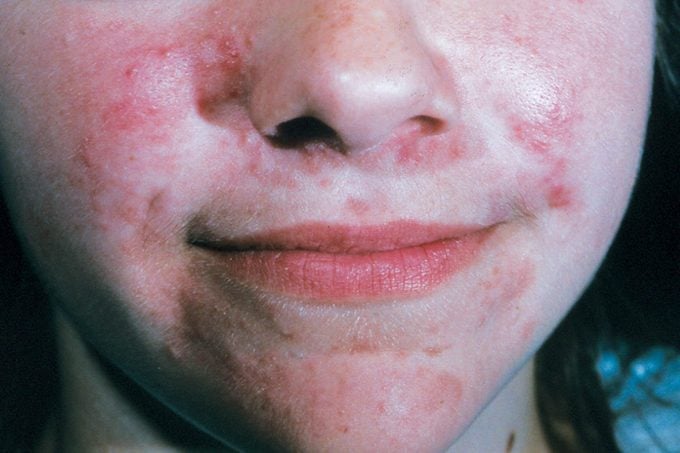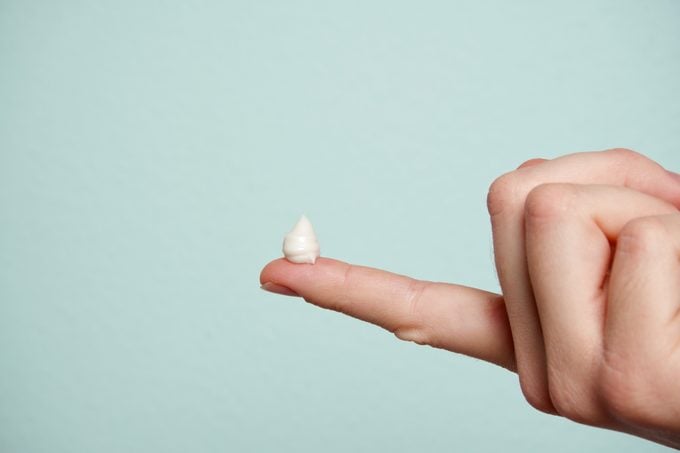Here’s How You Should Treat Perioral Dermatitis, According to Dermatologists
Updated: Oct. 21, 2020
Many people don't realize that perioral dermatitis is an acne or eczema-like rash around the mouth—and that you can treat it. Here's how to keep it at bay.

Don’t try to diagnose it on your own
Dr. Google may lead you down the wrong path with this rash. “Perioral dermatitis can mimic other conditions such as seborrheic dermatitis, rosacea, atopic dermatitis, and acne,” says Chris G. Adigun, MD, a dermatologist at Dermatology and Laser Center of Chapel Hill in Chapel Hill, NC. After all, there are several conditions that could cause a red face. “Thus, it is imperative to have a board-certified dermatologist evaluate your skin.” Is it eczema? Here’s how to tell.
See a doctor for antibiotics
For milder cases, antibiotics could do the trick. “Perioral dermatitis can be effectively treated with topical and oral antibiotics,” Dr. Adigun says. “Often treatment can be as short as one month in duration for milder cases.” Learn when you do—and don’t—need antibiotics.
Cut out offending products, if you can
Sometimes, clearing up the rash can be as simple as cutting back on what you put on your face—especially as some beauty products are notorious perioral dermatitis causes. “A ‘skin detox’ is often an effective strategy to treat mild perioral dermatitis,” says Mohiba Tareen, MD, a dermatologist at Tareen Dermatology in Roseville, MN, and Adjunct Clinical Assistant Professor of Dermatology at the University of Minnesota. “Stopping all products and just using a gentle cleanser and very light, unscented moisturizer may help.” According to Dr. Tareen, the most common culprits are fluoride toothpaste, lip balm, or scented or flavored topical products. Try these tips and tricks for glowing skin every day.

Be wary of topical steroids
Topical steroids may work for a bit—but could become a problem in the long run. “Topical steroids can suppress the rash, and consequently the eruption may flare when the steroid is discontinued,” Dr. Adigun says. “Eventually, the eruption will not respond to the topical steroid, and may even worsen with persistent application.” Check out the 13 things dermatologists won’t tell you.
Try a sulfur mask
If you’re looking for a perioral dermatitis treatment to try at home, a little “spa” time could help. “Mild episodes may clear up on their own,” says Melanie Palm, MD, a dermatologist with Art of Skin in Solana Beach, CA. “A consumer could try a topical sulfur mask to help.” See what that rash could be.
Skip tea tree oil and other natural remedies
They may work great on acne or other skin ailments, but those natural remedies could backfire with this condition. “Over-the-counter and natural products such as tea tree oil can be extremely irritating to the skin and may worsen perioral dermatitis,” Dr. Adigun says. “Even natural products can cause stinging when applied to open skin.” Here is the worst skin advice dermatologists hear.
Be prepared for a regimen of multiple creams
For the most severe cases, your doctor may prescribe a series of different medications to clear up the condition. “Most cases we see in the office are moderate to severe in nature and require topical antibiotics, anti-yeast medications, anti-inflammatories, or even antibiotics,” says Dr. Palm. “The gold standard treatments for most cases require prescription-strength medications.”

